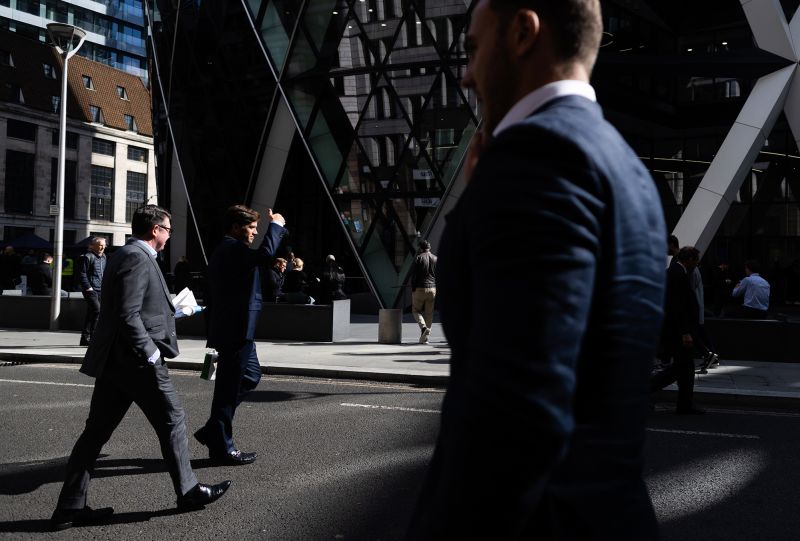Why the ghost of 2008 still haunts us in 2022 | CNN Business

This story is part of CNN Business’ Nightcap newsletter. To get it in your inbox, sign up for free, here.
New York
CNN Business
—
All week, there have events in the news that have come in under of the banner of “this hasn’t happened since 2007/2008.”
Yields on the 10-year Treasury briefly surpassed 4%, a level not seen since 2008. That movement helped push mortgage rates to their highest level, 6.7%, since — wait for it — July 2007. Across the pond, where the UK bond market crashed earlier this week, one seemingly frazzled London banker told the Financial Times: “At some point this morning I was worried this was the beginning of the end. It was not quite a Lehman moment. But it got close.”
The timing of all these events is indeed a bit spooky: Today, September 29, marks 14 years to the day that stock markets around the world cratered, ushering in the worst global financial crisis since the Great Depression.
With all that gloom, it’s natural to wonder whether history is about to repeat itself.
To be clear: The market ended up recovering completely — though it took years. And in so many ways, the economic and financial angst playing out around the world is absolutely not a repeat of the run-up to the Great Recession. It’s a whole different beast now.
But it is precisely because of those 2008 scars, still potent memories for many, that economists and analysts become nervous when things go as haywire as they have in recent weeks.
Right now, the prevailing mood is fear. Economies hobbled by inflation and soaring borrowing costs are vulnerable to economic shocks — whether those shocks come from a catastrophic hurricane, or a superpower declaring war on a neighbor, or a radical unfunded tax scheme. Or, heaven forbid, a resurgent pandemic.
All of that means there aren’t many good places for investors to put their money right now. Stocks and bonds are both in bear territory, and many analysts say the market could remain volatile until inflation gets under control (which, if we crash into a recession, could happen pretty soon… not a great silver lining, I know.)
If there’s a lesson to hold onto from the Great Recession, it’s not to panic. Per my colleague Jeanne Sahadi:
Let’s say you’d invested $10,000 at the start of 1981 in the S&P 500. That money would have grown to nearly $1.1 million by the end of March 2021. But had you missed just the five best trading days during those 40 years, it would only have grown to roughly $676,000.
In other words: Hold on tight, friends, and try to avoid looking at your 401(k) balance for the foreseeable future.
NUMBER OF THE DAY: 2.1%
Stocks fell Thursday, giving up Wednesday’s big gains and plunging the Dow back into a bear market.
The S&P 500, one of the broadest measures of the health of Corporate America, fell 2.1%, hitting a new low for the year. The Dow and S&P 500 are once again not far from their lowest levels since November 2020.
Heckuva way to wrap up the third quarter, eh? The stock market actually had a promising start to the quarter in July. But fears about inflation, rate hikes, rising bond yields and recession returned with a vengeance in August and September.
SO ON BRAND
Continuing a grand tradition of Corporate Rebranding Nonsense, Johnson & Johnson is putting all of its consumer health products under a newly formed parent company.
Soon, Band-Aid, Tylenol, Benadryl and Johnson’s baby powder will all be sold under the umbrella brand identity “Kenvue.”
That’s pronounced “Ken,” like the doll, “view.”
Here’s the deal: Johnson & Johnson, the owner of these labels, is in the process of splitting into two companies — one focused on medical devices and medications, the other on consumer health products, my colleague Nathaniel Meyersohn reports.
J&J is keeping its recognizable name for its larger pharmaceutical business, but it needed something new for the smaller consumer arm.
The company said Wednesday that it landed on Kenvue, a combination of “Ken,” an English word for knowledge primarily used in Scotland, and “vue,” a reference to sight.
“Kenvue” is the winning moniker that a small team from J&J, working with a naming agency, landed on. The goal was to be memorable. And, crucially, to clear trademarks in more than 100 markets and “pass linguistic and cultural screenings in 89 languages and dialects.”
The company also released Kenvue’s new logo — white letters against a green background, the limbs of the letter “K” resembling a sideways heart.
What does it mean? Absolutely nothing, and that is the point.
Corporations gravitate to names that are squeaky clean. There’s no possibility for a negative connotation, because it’s a made-up word. It doesn’t, as far as I can tell, sound like it might resemble a swear word in some other language. Kenvue is inoffensive. Bloodless. It is the tofu of corporate branding.
“It’s really just a holding company behind all these other brands,” one expert told Nathaniel. “They want a name that will disappear in the background and the brands will stick out.”
(Mission accomplished. I’ve already forgotten the new name and I just typed it 40 seconds ago.)
MY TWO CENTS
The best review I can give of the new brand is that it’s forgettable. Other companies have famously (infamously?) failed to stick the landing with new names.
Netflix, back in 2011, quickly backtracked after trying to rechristen its DVD mailing service as “Qwikster.” More recently, Fiat Chrysler and PSA Group merged in 2020 under the collective name “Stellantis,” which is still the company’s name, but I still think it sounds like something you should ask your doctor about if you have signs of seasonal depression.
Enjoying Nightcap? Sign up and you’ll get all of this, plus some other funny stuff we liked on the internet, in your inbox every night. (OK, most nights — we believe in a four-day work week around here.)







